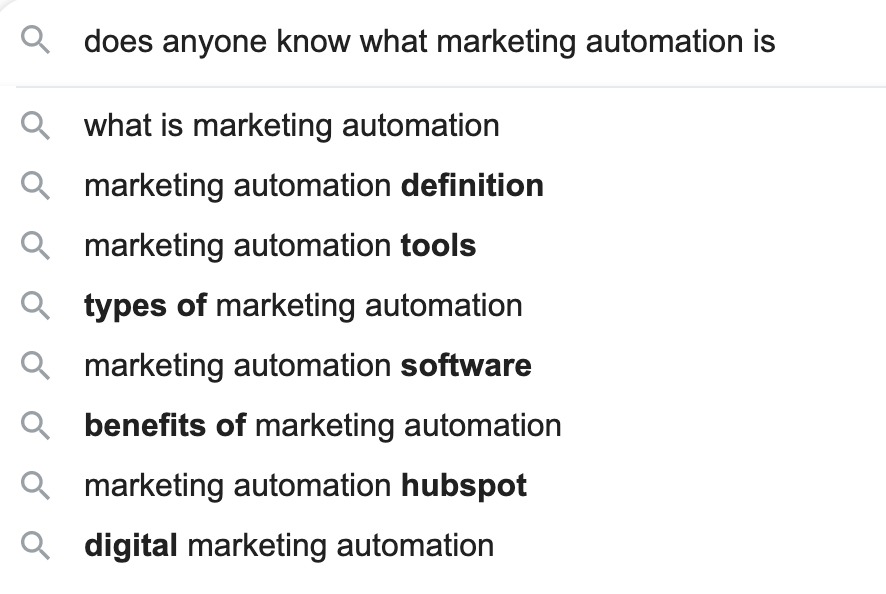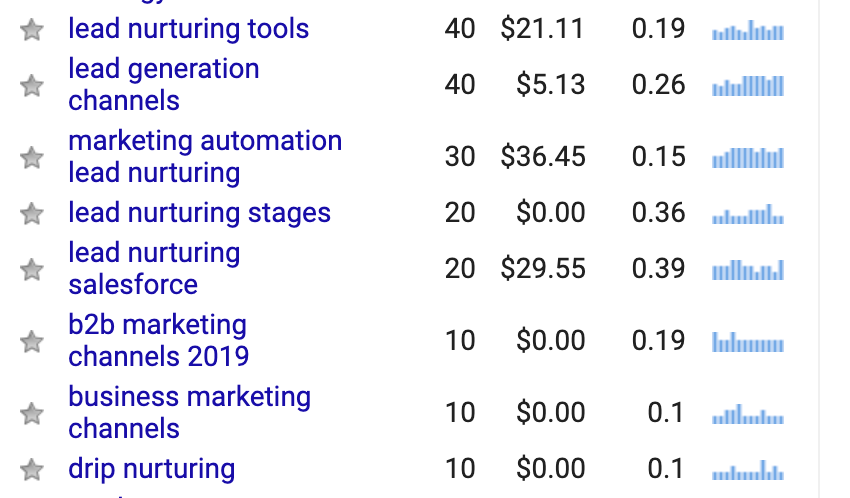What is Your Keyword Strategy? The 4 Stages of Discovery
A content marketer pursuing search as a strategy will bump into an inevitable question at some point: which keywords do I pursue? And in what order do I pursue them?
Below, I’ll break down some common thought processes for keyword strategy and how you can iterate on each one.
1. BAD: Go after keywords in your niche.
My company does “X” and “Y” so I’ll pursue keywords in my niche. This is a very common strategy, and one that needs some refining. Why?
Because in (most) niches and industries, the most basic and obvious keywords may not fully encapsulate your product.
For example, my niche with GrowthContent is “content marketing.” But guess what? I don’t have the domain authority to rank for a word like that. What does that mean? Essentially, my site isn’t big enough to compete for that ginormous word.
According to KeywordsEverywhere, the word “content marketing” receives 14,800 searches per month. So there is lots of interest!
Ahrefs pegs it at 28,000 searches per month.
WHOA!
That’s even better. More searches!

THUD!
That’s the keyword difficulty punching you in the gut. The Keyword Difficulty (KD) for the keyword “content marketing” is at 89, meaning it is one of the most difficult words to rank for.
The higher your domain authority, the easier it is to rank for competitive keywords like that.
For that keyword, the Neil Patels and Hubspots and Content Marketing Institutes are large and in charge. And if I’m going for a big, broad word like that, a lot of my traffic won’t necessarily be interested in content marketing services. They are just trying to understand it or find out the basics. I can let someone else do that type of educational content.
For meaningful traffic, I’ll have to go a bit deeper…
2. STILL BAD: Go after lower volume keywords in your niche.
These work in 2 ways:
Some of these could be words that help you rank and gain attention. They could be top of the funnel words (meaning not high-converting words) but don’t have as much search volume. Confused?
Let’s pick on marketing automation, a very popular SaaS category.

There you go. A long-tail keyword. Very little volume. Very little competition. Bingo.
Except…what does this word accomplish? It’s actually serving top of the funnel needs, just re-phrased in a different way.
In fact, Google points me towards more popular, yet relevant searches:

So that word is not good, because you’ll be competing with the top pages you were hoping to avoid in number 1.
Your long-tail keywords work best when they are combined with a high-intent to buy, purchase, or make a decision. Usually, these have lower monthly search volumes.
3. BETTER: Go after low volume, high-intent keywords in your niche.
Now, we’re getting somewhere. This is where you should start. When I was working with ClickUp (a project management software company), we created several comparison pages to our top competitors. We knew that users liked changing tools but also needed guidance on what awaited them in that change.
These keywords didn’t always get the highest volume, and sometimes didn’t show up at all in SEO tools, but many people who were willing to try our product used those terms.
How can you find quality, high-intent keywords?
1) Look at your competitors. See how you are different. Exploit those differences as opportunities. Use your content to amplify your differentiation.
2) Talk to your customers. What are their concerns and questions? How can you answer their objections? Use those answers and your sales collateral in your content marketing.
3) Take some time. Do some work. A lot of people think because the tools are available, that they’ll have all the answers for you. That’s not the case. You still have to know how to use the tools well. That means exploring topics in-depth, rethinking how you message your product, and re-engineering from the top results.
4) BEST: Go after low-volume, high-intent keywords in one of your niche(s).
Okay, now we’re really breaking stuff down. All B2B software companies think that their product does a lot of things well.
Their product can order the world’s best fair trade coffee, and slice lemons perfectly, and always remembers to feed the cat while finding the top sales leads.
Maybe not that, but you see what I mean. We often want our products to work for everyone, no matter the situation.
This doesn’t work well in content marketing (or in business).
Here’s why: Google wants you to be an expert in a thing not all things. This is often called the E-A-T doctrine. (Don’t know if it’s a real doctrine, but yeah).
If you’re just starting out with content marketing, this is the route I suggest that you go. You can show mastery in one area and then move onto another one.
For example, if I’m in marketing automation, you probably offer email templates, landing pages, list management, lead nurturing, and all these cool things.
Instead of skipping around between all of those topics on your blog, start with one and max it out.
Find a broad topic and focus on the low-volume, high-intent words around that.
“Lead nurturing” is a very popular and fairly difficult keyword. Using my keyword tools, it has approximately 700-1000 searches per month, and an Ahrefs difficulty score off 47.
If you’re just starting out, that may be too much work with very little traffic. And any traffic you do get may not be in a buying mode. Instead, words like “lead nurturing strategies” (170 searches per month) or the lesser-known “lead engagement” (40 searches per month) may offer more qualified traffic.
Then how do you keep building? You look for related keywords and phrases while also talking to your SMEs and customers about “lead nurturing” or “lead engagement.”
Also, handy? Many keyword tools have “related searches” and Google even offers a few of these too. This is from Keywords Everywhere:

These keywords aren’t perfect, but they are a place to start.
3 Keyword Strategy Takeaways:
- Go for long-tail keywords with a high-intent to buy or make a decisionn
- Don’t try and compete on the educational content until your domain authority and brand is well established
- Start with one product feature or benefit, build content around that topic, and then expand from there
